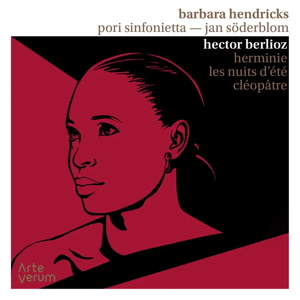
Hector Berlioz (1803-1869)
Herminie, cantate pour le Prix de Rome, H.29 (1828)
Les nuits d’été, Op. 7, H.81 (1848)
Cléopâtre, Scène lyrique, H.36 (1829)
Barbara Hendricks (soprano), Pori Sinfonietta/Jan Söderblom
Notes & texts in French, English & German
rec. live, 5-9 April 2016, Promenade Hall, Pori, Finland
Arte Verum ARV016 [72]
In my survey of Berlioz’ Les Nuits d’été, I willingly endorsed Barbara Hendricks ‘ account made in 1993 when she was in her mid-forties; testament to the longevity of her career comes in this recording on her own label of those songs and two of Berlioz’ cantatas recorded live in Finland in 2016, when she was 67. She is still performing at 75 years old as I write.
Here is what I wrote of that earlier recording: “I really like Barbara Hendricks’ instantly recognisable lyric soprano, with its trilling, throbbing pulse and slightly husky timbre. Her special affinity with French language and music has been recognised in France by the affection of the French public and she was made a Chevalier of the Légion d’honneur in recognition of that; this recital shows why. I am, however, disappointed by the rather stolid tempo Colin Davis adopts for the opening song; he seems to favour that pace in all three of his recordings, and I think it requires a lighter, brisker touch. This is a small flaw; otherwise his direction is alert, sensitive and deeply felt, with the ECO providing a lovely clarity in the instrumental lines.
A handicap common to many voices like Hendricks’ is a lower register which isn’t especially dark or strong but like Steber before her she finds considerable heft, even reaching down to the low F, and in alt her voice, again like Steber, soars over the lines above the stave; I am really impressed by the power and intensity of her singing and think this one of the very best soprano versions.”
So how does this performance, nearly a quarter of a century later, measure up? Her tone is largely unchanged – pure yet paradoxically husky with that lower register still serviceable, her intonation secure and her pronunciation clear; the main problem is that the vibrato has loosened to the extent that its oscillation is too wide and it is at times close to a wobble. That is probably exaggerated by the recording process and I can imagine that hearing her sing live is still quite pleasurable – and she sounds much better when singing softly, with the voice under less pressure, but there is no doubt that we are listening to a mature singer and the raison d’être of the recording is doubtful.
The orchestral accompaniment is excellent; dynamics are sensitively observed by conductor Jan Söderblom and there is much delicate, nuanced playing.
The two cantatas are also up against stiff recorded competition: Hendricks mentions Janet Baker’s Berlioz in her notes and even if Herminie is not Berlioz’ finest work, it receives better advocacy from Dame Janet in youthful voice; Hendricks does not sound as vocally comfortable here, frequently becoming cloudy and unsteady. Those who do not know the work will be surprised to hear first the familiar idée fixe theme from the Symphonie fantastique and again, the orchestral playing is first class. The problem of the competition becomes more acute in the case of La mort de Cléopâtre, of which we have stunning recordings from Janet Baker and Jessye Norman, both in their absolute prime. However, Hendricks is either in better voice here, or the role suits her better than Herminie, as much that she does is commendable and dramatically compelling – and yet again, I admire the flexibility of Söderblom’s accompaniment; sections flow neatly and he encompasses all the fleeting moods successfully.
On one hand, I feel ungallant in not commending sufficiently Hendricks’ remarkable vocal endurance but on the other it would be doing no service to the singer or the prospective purchaser to fail to observe that the recordings by her younger self and the two aforementioned artists constitute a much better option than what is on offer here.
Ralph Moore




















